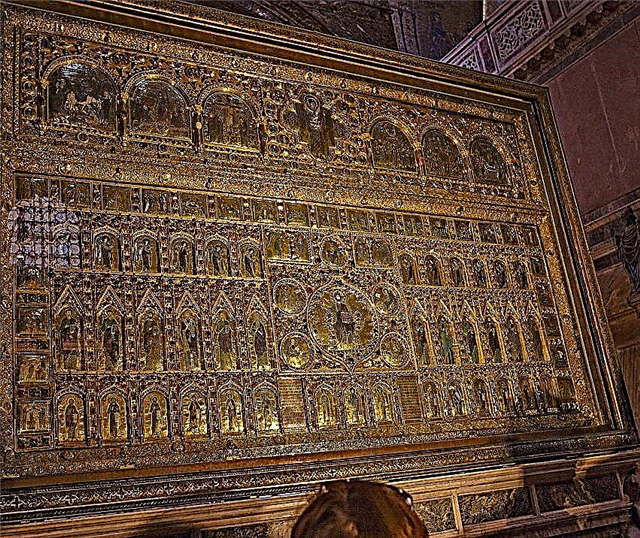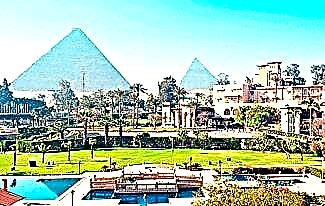St. Mark's Cathedral is an architectural gem of Venice and Italy, a unique creation recognized throughout the world as a classic of Byzantine church architecture. It amazes with its majesty, uniqueness of architecture, skillful decoration of facades, luxury of interior design and exciting centuries-old history.
History of St. Mark's Cathedral
The location of the relics of St. Mark the Evangelist until 828 was the city of Alexandria. During the suppression of the peasant uprising that broke out there, Muslim punishers destroyed many Christian churches and destroyed shrines. Then two merchants from Venice sailed to the shores of Alexandria in order to protect the relics of St. Mark from vandalism and take them home. To get through customs, they resorted to a trick, hiding the basket with the remains of St. Mark under the pork carcasses. Their hope that Muslim customs officials would disdain to lean against pork was justified. They crossed the border successfully.
Initially, the relics of the apostle were placed in the church of St. Theodore. By order of the Doge Giustiniano Partechipazio, a basilica was erected to store them near the Doge's Palace. The city acquired the patronage of Saint Mark, his sign in the form of a golden winged lion became the symbol of the capital of the Venetian Republic.
The fires that engulfed Venice in the 10th-11th centuries led to several rebuildings of the temple. Its reconstruction, close to today's appearance, was completed in 1094. A fire in 1231 damaged the church building, as a result of which restoration work was carried out, which ended with the creation of the altar in 1617. The majestic temple from the outside and from the inside appeared more beautiful than the previous one, adorned with statues of saints, angels and great martyrs, amazing carved decor of the facades.
The cathedral became the main cult site of the Venetian Republic. Doges' coronations were held in it, famous sailors received blessings, going on long journeys, townspeople converged on days of celebrations and troubles. Today it serves as the seat of the Venetian Patriarch and is a UNESCO World Heritage Site.
Architectural features of the cathedral
The Cathedral of the Twelve Apostles became the prototype of the Cathedral of St. Mark. Its architectural structure is based on a Greek cross, completed with a volumetric dome in the center of the intersection and four domes over the sides of the cross. The temple with an area of 4 thousand square meters rushes up to 43 meters.
Numerous renovations of the basilica have harmoniously combined several architectural styles.
The façades harmoniously combine oriental marble details with Romanesque and Greek bas-reliefs. Ionian and Corinthian columns, Gothic capitals and many statues lend a divine majesty to the temple.
On the central western façade, attention is drawn to 5 portals decorated with 18th century mosaic tympans, sculptural masterpieces from ancient to medieval times. The top of the main façade is decorated with thin turrets added 6 centuries ago, and in the center above the entrance there is a statue of St. Mark, surrounded by figures of angels. Beneath it, the figure of a winged lion shines with a golden sheen.
The southern facade is interesting for a pair of 5th century columns with carvings in the Byzantine style. At the outer corner of the treasury, sculptures of four tetrarch rulers of the 4th century, brought from Constantinople, attract the eye. Exquisite Romanesque carvings from the 13th century adorn most of the outer walls of the temple. Over the centuries, the building was completed with a vestibule (XII century), a baptistery (XIV century) and a sacristy (XV century).
The luxury of interior decoration
The decoration inside the Cathedral of St. Mark, made in the traditional Venetian style, causes delight and an unprecedented spiritual uplift. The photos inside are amazing with the huge area and the beauty of the mosaic paintings covering the vaults, the surface of the walls, domes and arches. Their creation began in 1071 and lasted almost 8 centuries.
Narthex mosaics
The narthex is the name of the church vestibule that precedes the entrance to the basilica. Its annex with mosaic paintings illustrating Old Testament scenes dates back to the 12th-13th centuries. Here you see:
- The dome about the creation of the world, decorated with golden scales and attracting attention with the image of 6 days of the creation of the world from the book of Genesis.
- The arches of the doors that open the entrance to the temple attract attention with a cycle of mosaics about the life of the forefathers, their children, the events of the Flood and some biblical scenes.
- The three domes of Joseph in the north side of the narthex introduce 29 episodes from the biblical life of Joseph the Beautiful. On the sails of the domes, figures of prophets with scrolls appear, where prophecies about the appearance of the Savior are written.
- The dome of Moses is painted with mosaics of 8 scenes of the acts committed by the prophet Moses.
Plots of mosaics of the cathedral interior
The mosaics of the cathedral continue the mosaic narratives of the narthex associated with the expectation of the appearance of the messiah. They illustrate the lifetime deeds of Jesus Christ, the life of the Most Holy Theotokos and the Evangelist Mark:
- From the dome on the central nave (the elongated room of the cathedral), the Mother of God looks out, surrounded by the prophets. The theme of the fulfillment of prophecies is devoted to 10 wall mosaic paintings and 4 scenes above the iconostasis, made according to the sketches of the famous Tintoretto in the XIV century.
- Mosaics of the transverse nave (transept), telling about the events described in the New Testament and the blessings of Jesus, became the decoration of the walls and vaults.
- The picturesque canvases of the arches above the central dome show pictures of the torment experienced by Christ, from the crucifixion to the Resurrection. In the center of the dome, a picture of the Savior's Ascension to heaven appears before the parishioners.
- In the sacristy, the top of the walls and vaults is decorated with a series of 16th century mosaics, made according to Titian's sketches.
- A work of art is the floor of multi-colored marble tiles, stacked in geometric and floral patterns depicting the inhabitants of the earth's fauna.
Golden altar
An invaluable relic of the Cathedral of St. Mark and Venice is considered the "golden altar" - Pala D'Oro, which was created for about 500 years. The height of the unique cult creation is over 2.5 meters, and the length is approximately 3.5 meters. The altar attracts attention with 80 icons in a gold frame, decorated with many precious stones. It boggles the mind with 250 enamel miniatures created using a unique technique.
The center of the altar is assigned to Pantokrator - the heavenly king, seated on the throne. On the sides it is surrounded by round medallions with the faces of the apostles-evangelists. Above his head are medallions with archangels and cherubs. On the upper rows of the iconostasis there are icons with gospel themes, from the icons on the lower rows the forefathers, great martyrs and prophets look. On the sides of the altar, images of the life of St. Mark follow vertically. The treasures of the altar are freely accessible, which makes it possible to see all the details and enjoy the divine beauty.
Bell Tower of Saint Mark
Near the Cathedral of St. Mark stands Campanile - a cathedral bell tower in the form of a square tower. It is completed by a belfry crowned with a spire, on which the copper figure of the Archangel Michael is installed. The total height of the bell tower is 99 meters. Residents of Venice lovingly call the bell tower of St. Mark "the mistress of the house." Throughout its long history dating back to the 12th century, it has served as a watchtower, lighthouse, observatory, belfry and a magnificent observation deck.

In the fall of 1902, the bell tower suddenly collapsed, after which only the corner part and the 16th century balcony with marble and bronze decor survived. The city authorities decided to restore the Campanile in its original form. The renovated bell tower was opened in 1912 with 5 bells, one of which has survived the original, and four were donated by Pope Pius X. The bell tower offers an amazing panorama of Venice with the nearby islets.
Interesting facts about St. Mark's Cathedral
- The large-scale construction of the Church of San Marco used about a hundred thousand larch logs, which only became stronger under the influence of water.
- More than 8000 sq. M. Are covered with mosaics on a gold background. m of vaults, walls and domes of the temple.
- The "Golden Altar" is decorated with 1,300 pearls, 300 emeralds, 300 sapphires, 400 garnets, 90 amethysts, 50 rubies, 4 topaz and 2 cameos. The relics of St. Mark lie in a reliquary under it.
- The enamel medallions and miniatures that adorned the altar were selected by the crusaders in the Pantokrator monastery in Constantinople during the fourth campaign and presented to the temple.
- The cathedral's treasury exhibits a collection of Christian relics, gifts from the popes and about 300 items obtained by the Venetians during the defeat of Constantinople at the beginning of the 13th century.
- A quadriga of bronze horses, cast in the 4th century BC by Greek sculptors, is kept in the treasury of the basilica. A clever copy of them appears at the top of the facade.
- Part of the basilica is the chapel of St. Isidore, revered by the Venetians. In it, under the altar, rest the remains of the righteous.

Where is the cathedral, opening hours
The Cathedral of Saint Mark rises on Piazza San Marco in the center of Venice.
Opening hours:
- Cathedral - November-March from 9:30 to 17:00, April-October from 9:45 to 17:00. The visit is free. The inspection takes no more than 10 minutes.
- The "Golden Altar" is open to the public: November-March from 9:45 am to 4:00 pm, April-October from 9:45 am to 5:00 pm. Ticket price - 2 euros.
- The treasury of the temple is open: November-March from 9:45 to 16:45, April-October from 9:45 to 16:00. Tickets cost 3 euros.
We recommend looking at St. Peter's Cathedral.
On Sundays and public holidays, the cathedral is open to tourists from 14:00 to 16:00.
To bow to the relics of St. Mark, see frescoes of the 13th century, relics from the churches of Constantinople, which became trophies of the crusaders' campaigns, there are endless streams of believers and tourists.









